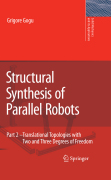
Structural synthesis of parallel robots pt. 2 Translational topologies with two and three degrees of freedom
Gogu, G.
This book represents the second part of a larger work dedicated to the structural synthesis of parallel robots. The originality of this work resides in thefact that it combines new formulae for mobility connectivity, redundancy and overconstraint, and the evolutionary morphology in a unified approach of structural synthesis giving interesting innovative solutions for parallel robotic manipulators. This is the first book of robotics presenting solutions of coupled, decoupled, uncoupled, fully-isotropic and maximally regular translational parallel robotic manipulators systematically generated by using the structural synthesis approach proposed in Part 1. Non-redundant/redundant, overconstrained/isostatic solutions with simple/complex limbs actuated by linear/rotary actuators with/without idle mobilities are proposed. Many solutions are presented here for the first time in the literature. Structural synthesis of parallel robots with two to six degrees of freedom New families of parallel robots with decoupled, uncoupled and fully-isotropic solutions Non-redundant/redundant, overconstrained/isostatic solutions of coupled/decoupled/ uncoupled and fully-isotropic parallel manipulators with elementary/complex legs actuated by linear/rotary actuators with/without idle mobilities INDICE: From the contents Preface. 1. Translational parallel robots with two degrees of freedom T2-type. 2. Parallel robots with screw motion T1R1-type.3. Other parallel robots with two degrees of freedom T1R1-type. 4. Spherical parallel wrists with two degrees of freedom R2-type. 5. Translational parallelrobots with three degrees of freedom. 6. Parallel robots with planar motion T2R 1-type. 7. Other parallel robots with three degrees of freedom T2R 1-type. 8. Parallel robots with three degrees of freedom T1R2-type. 9. Spherical parallel wrists with three degrees of freedom R3-type. 10. Parallel robots with Schönflies motion T3R 1-type. 11. Other parallel robots with four degrees of freedom T3R1-type. 12. Parallel robots with four degrees of freedom T2R2-type. 13.Parallel robots with four degrees of freedom T1R3-type. 14. Parallel robots with five degrees of freedom T3R2-type. 15. Parallel robots with five degrees of freedom T2R3-type. 16. Parallel robots with six degrees of freedom.
- ISBN: 978-1-4020-9793-5
- Editorial: Springer
- Encuadernacion: Cartoné
- Páginas: 780
- Fecha Publicación: 01/01/2009
- Nº Volúmenes: 1
- Idioma: Inglés
